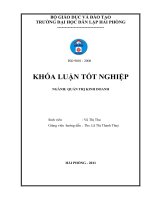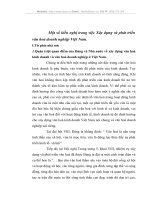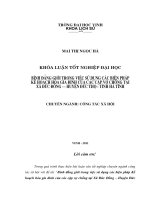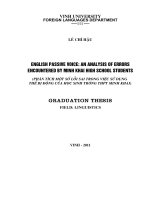Luận văn english passive voice an analysis of errors encountered by minh khai high school student = phân tích một số lỗi sai trong việc sử dụng thể bị động của học sinh trường THPT minh khai luận văn tốt nghiệp đại học
Bạn đang xem bản rút gọn của tài liệu. Xem và tải ngay bản đầy đủ của tài liệu tại đây (346.99 KB, 51 trang )
vinh university
foreign Languages department
=== ===
lª chÝ hËu
English passive voice: An analysis of errors
encountered by Minh Khai high school students
(Phân tích một số lỗi sai trong việc sử dụng
thể bị động của học sinh trờng thpt minh khai)
graduation thesis
FIELD: LINGUISTICS
Graduation thesis
Vinh - 2011
Hoàng Thị Thảo – K48A1 English
2
vinh university
foreign Languages department
=== ===
English passive voice: An analysis of errors
encountered by Minh Khai high school students
(Ph©n tích một số lỗi sai trong việc sử dụng
thể bị ®éng cña häc sinh trêng thpt minh khai)
graduation thesis
Field: Linguistics
Supervisor: nguyễn thị tờng, m.a
Student:
lê chí hậu, 48A1 - English
Graduation thesis
VINH, MAY 2011
Hoàng Thị Thảo – K48A1 English
GRADUATION THESIS
ACKNOWLEDGEMENT
My thesis cannot be completed without the help and support of my
lecturers, my friends and my family.
First of all, I would like to express my deepest gratitude to my
supervisor, Ms Nguyen Thi Tuong, M.A, for her readiness at all time to give
me the expert advices, useful critical comments, important materials, without
which my thesis would not have been completed.
I would like to give my thanks to students of class 12A1 and 12A2 of
Minh Khai High School in Duc Tho district, Ha Tinh province.
I would also like to express my greatest thanks to all the teachers for
their useful lectures, which build the base for theoretical as well practical
knowledge.
Finally, the sincere thanks to my friends and my family who stand by to
help and encourage me a lot in various kinds and unconditional support.
VINH, 2010
LE CHI HAU
Le Chi Hau - 48A1 English
i
Foreign Languages Department
GRADUATION THESIS
TABLE OF CONTENT
Page
ACKNOWLEDGEMENT.................................................................................i
TABLE OF CONTENT....................................................................................ii
LIST OF TABLE ............................................................................................iv
LIST OF ABBREVIATIONS AND SYMBOLS..............................................v
PART A: INTRODUCTION.............................................................................1
1. Rationale for the study..................................................................................1
2. Aims of the study..........................................................................................1
3. Scope of the study.........................................................................................2
4. Method of the study.......................................................................................2
5. Design of the study........................................................................................2
PART B: CONTENTS......................................................................................3
CHAPTER I: THEORETICAL BACKGROUND............................................3
1.1. An Overview of passive voice....................................................................3
1.1.1. General description of Passive Voice......................................................3
1.1.1.1. What is Passive Voice?........................................................................3
1.1.2.2. Function of the word “by” in passive sentences...................................4
1.2.3. When is passive voice used?...................................................................4
1.2. Passive voice construction..........................................................................6
1.2.1. Canonical passive....................................................................................6
1.2.2. Promotion of other objects......................................................................6
1.2.3. Stative Passive.........................................................................................7
1.2.4. Doubled Passive .....................................................................................8
1.2.5. Adjective Passive....................................................................................8
1.2.6. Promotion of content clauses..................................................................9
1.2.7. Passives without active counterparts.......................................................9
1.2.8. Tenses and Modal verb Passive
....................................9
1.3. Error in language and learning process....................................................11
1.3.1. Definition of errors................................................................................11
1.3.2. The distinction between Errors and Mistakes.......................................12
1.3.3. Error Analysis.......................................................................................12
1.3.4. Cause of Errors......................................................................................13
1.3.4.1. Interlingual errors and mother tongue interference............................13
1.3.4.2. Intralingual errors and developmental errors ....................................14
1.3.5. The ways of Errors correction...............................................................16
CHAPTER II: THE STUDY...........................................................................17
2.1. Research Question....................................................................................17
2.2. Research settings .....................................................................................17
2.3. Description of subjects.............................................................................17
Le Chi Hau - 48A1 English
ii
Foreign Languages Department
GRADUATION THESIS
2.4. Data collection..........................................................................................18
2.5. Procedure .................................................................................................18
2.6. Preliminary results and data collection.....................................................19
2.6.1. Results and errors in part 1 ...................................................................19
2.6.2. Results of errors in part 2 .....................................................................20
2.6.3. Results of part 3.....................................................................................20
2.6.4. Result of part 4......................................................................................21
2.7. Errors and their causes.............................................................................22
2.7.1. Errors and their causes in part 1............................................................22
2.7.2. Errors and their causes in part 2............................................................24
2.7.3. Errors and their causes in part 3............................................................26
2.7.4. Errors and their causes in part 4............................................................28
CHAPTER III: FINDINGS AND IMPLICATIONS......................................30
3.1. Research question revisited......................................................................30
3.1.1. Research question 1...............................................................................30
3.1.1.1. Tenses.................................................................................................30
3.1.1.2. Modal Verb passive ..........................................................................30
3.1.1.3. Stative verb and Adjective passive.....................................................30
3.1.2. Research question 2 ..............................................................................31
3.1.3. Research question 3 ..............................................................................31
3.2.1. Suggestions for explaining the lesson...................................................31
3.2.2. Suggestions for Practice ......................................................................32
3.2.3. Suggestions for Learning English passive voice...................................36
3.3. Suggestions for further research...............................................................36
PART C: CONCLUSION...............................................................................37
REFERENCES................................................................................................38
APPENDIX.....................................................................................................40
SUGGESTED ANSWER................................................................................42
Le Chi Hau - 48A1 English
iii
Foreign Languages Department
GRADUATION THESIS
LIST OF TABLE
Table 2.1. Results of part 1.............................................................................19
Table 2.2. Results of part 2..............................................................................20
Table 2.3.Results of part 3...............................................................................21
Table 2.4. Results of part 4..............................................................................22
Le Chi Hau - 48A1 English
iv
Foreign Languages Department
GRADUATION THESIS
LIST OF ABBREVIATIONS AND SYMBOLS
Etc.
Et cetera
E.g.
Example
PII
Past Participle
L1
First Language
L2
Second Language
No
Number
%
Percentage
*
Unacceptable Expression
Changing from active into passive
Le Chi Hau - 48A1 English
v
Foreign Languages Department
GRADUATION THESIS
PART A: INTRODUCTION
1. Rationale for the study
Nowadays, English becomes an important part in daily life. It is used
popularly and widely over the world. English is an effective mean of
communication and information exchange. The globalization makes English
as the international language that everyone wishes to possess and Vietnamese
learners are not out of the orbit.
English has not been the L1 or L2 in Vietnam but the most updated
foreign language in comparison with the other one. It is used as the major
subject.
However, each language has its own characteristics and rules. Learners
encounter lot difficulties. One of the difficulties is the use of passive voice in
writing. Thus, it is not easy for students to use English passive voice
effectively. They usually confuse with the tenses, modal verbs, and stative
verbs in passive voice.
In process of learning, the Vietnamese learners especially the high
school students caused many errors and faced up with the tasks of acquiring a
second language. The errors need to be found and find the way to improve.
This problem has given an impetus to this study that aims at examining
various use of English passive voice and the typical errors made by
Vietnamese learners as well.
For these reasons above the author has made decision to choose:
“English passive voice: An analysis of errors encountered by Minh Khai
high school students” to be the theme of the thesis.
2. Aims of the study
The study reported in this thesis aims at to:
Le Chi Hau - 48A1 English
1
Foreign Languages Department
GRADUATION THESIS
• Identifying common errors in using English passive voice
• Finding out the main causes and sources of errors made by high
school students
• Making some suggestions for teaching and learning English passive
voice in writing
3. Scope of the study
The study does no hope to display all the aspects of English passive
voices. The author focuses on finding and analysis all errors that are
encountered by students in using English passive voice in wring and find out
the related reasons.
4. Method of the study
The study based on some methods below:
• Collective Method
• Descriptive method
• Investigation method
• Analysis method
5. Design of the study
This study is divided into three main parts:
• Part A: INTRDUCTION
• Part B: CONTENTS
Chapter 1: Theoretical Background
Chapter 2: The study
Chapter 3: Finding and implication
•
Part C: CONCLUSION
Le Chi Hau - 48A1 English
2
Foreign Languages Department
GRADUATION THESIS
PART B: CONTENTS
CHAPTER I: THEORETICAL BACKGROUND
In this chapter, the overview of passive voice will be presented to make
the theoretical background. Then the definition of error, error analysis and the
ways of error correction will be dealt with as well.
1.1. An Overview of passive voice
1.1.1. General description of Passive Voice
1.1.1.1. What is Passive Voice?
The passive voice is a grammatical construction (a "voice") in which the
subject of a sentence or clause denotes the recipient of the action (the patient)
rather than the performer (the agent). In the English language, the English
passive voice is formed with an auxiliary verb (usually be or get) plus a
participle (usually the past participle) of a transitive verb.
Passive voice is an active tense is formed by putting the verb “to be” into
the same tenses as the active verb and adding past participle of active verb.
The Subjects of the active verb become the agents of the passive verb. When
the agent of the passive verb is mentioned, it is preceded by word “by” and
placed at the end of the clause.
Formation: A to be done (by B) that is illustrated as follow:
Active sentence: S1
Passive voice: S2
Le Chi Hau - 48A1 English
3
+
+
V +
O
to be + V (PII) +
by+ S1
Foreign Languages Department
GRADUATION THESIS
E.g.
They built this house 2 days ago.
S
V
O
This house was built by them 2 days ago.
However, in some cases the agent is not mentioned, the word “by” is not
necessary to use.
E.g.
People suspected he broke the window.
He was suspected that he broke the window.
1.1.2.2. Function of the word “by” in passive sentences
To make an active sentence into a passive sentence move the previous
object to the subject position and the previous (now called agent) to the end
of the verb phrase with “by”.
In some case, “by” is omitted. However, it is kept when the “agent” that
causes the action in the active sentence is rather important.
E.g.
Hung made this toy.
This toy was made by Hung
1.2.3. When is passive voice used?
It is believed that the Academic English passive voice are used more
than active voice but writers may choose passive for following reasons.
• When we do not know, do not know exactly, have forgot or even we do
not care who did the action or the agent is unimportant or unknown. Let
consider these examples:
1. My bag has been stolen.
2. The child was struck by the car.
3. The store was robbed last night.
4. Plows should not be kept in the garage.
5. This house is being repainted.
Le Chi Hau - 48A1 English
4
Foreign Languages Department
GRADUATION THESIS
• When we are more interested in the action than the person who does it.
That means it is not necessary to mention the doer of the action as it is
obvious who he is (was /will) be.
E.g.
1. The key was not left.
2. The rubbish has not been collected.
3. The sea is being cleaned.
• When the Subject of the active sentence would be indefinite pronoun
“one”.
E.g.
One sees that he is reliable.
It is seen that he is reliable.
• When the subject of the active verb would be “ people”
E.g.
People believed that there is ghost in this house.
This house is believed to have ghost.
• When the subject of the active verb would be the indefinite pronoun
“one”.
E.g.
A new road has been built by (our local council)
• The passive voice may be used to avoid an awkward or ungrammatical
sentence. This is usually done by avoiding a change of sentence. For
example, the sentence: “When he came, his car was dragged.” is better
than the sentence: “When he came, a police’s car dragged his car.”
• The passive voice may be used to be indirect, that is, to avoid to blame.
E.g.
He has broken your window.
Your window has been broken.
• The passive voice may be used to avoid a “weak” somebody in the
active voice. We can see in this example:
Le Chi Hau - 48A1 English
5
Foreign Languages Department
GRADUATION THESIS
Everyone thinks she is crazy
It is thought that she is crazy.
• The passive voice may be used to avoid problem with masculine
/feminine pronoun.
E.g.
Applicant must enclose his/her photo in the application bag.
Each applicant’ photo must be enclosed in each
application bag.
1.2. Passive voice construction
1.2.1. Canonical passive
Passive constructions have a range of meanings and uses. The canonical
use is to map a clause with a direct object to a corresponding clause where
the direct object has become the subject.
E.g.
The goalkeeper caught the ball.
Here caught is a transitive verb with the goalkeeper its subject and the ball
as its direct object. If we recast the verb in the passive voice (was caught), then
the ball becomes the subject (it is "promoted" to the subject position) and
goalkeeper disappears: this sentence will be: The ball was caught. The original
"demoted" subject can typically be re-inserted using the preposition by.
The ball was thrown by the goalkeeper.
1.2.2. Promotion of other objects
One non-canonical use of English's passive is to promote an object other
than a direct object. It is usually possible in English to promote indirect
objects as well. For example:
He gave Daisy a rose on her birthday
Daisy was given a rose on her birthday.
Le Chi Hau - 48A1 English
6
Foreign Languages Department
GRADUATION THESIS
Or,
He gave Daisy a rose on her birthday.
A rose was given to Daisy by him
In the active form, gave is the verb; He is its subject, Daisy is indirect
object, and a rose is direct object. In the passive forms, the indirect object has
been promoted and the direct object has been left in place. (In sentence: “A
rose was given to Daisy", the direct object is promoted and the indirect object
left in place. In this respect, English resembles.
It is also possible, in some cases, to promote the object of a preposition:
They talked about the problem.
The problem was talked about.
In the passive form here, the preposition is "stranded", that is, an object does
not follow it.
1.2.3. Stative Passive
The passives described above are all eventive (or dynamic) passives.
Stative (or static, or resultative) passives also exist in English, rather than
describing an action, they describe the result of an action. English does not
usually distinguish between the eventive passive and stative passive. For
example, “The roof of the house was damaged”. This sentence has two
different meanings, roughly the following:
1. (Someone or something) damaged the roof of the house
2. The roof of the house was not intact.
The former meaning represents the canonical, eventive passive: the
latter, the stative passive. (The terms eventive and stative/resultative refer to
the tendencies of these forms to describe events and resultant states,
respectively. The terms can be misleading, however, as the canonical passive
of a stative verb is not a stative passive, even though it describes a state.)
Le Chi Hau - 48A1 English
7
Foreign Languages Department
GRADUATION THESIS
Some verbs do not form stative passives. In some cases, this is because
distinct adjectives exist for this purpose, such as with the verb open:
1. The door was opened.
[Someone] opened the door.
2. The door was open.
The door was in the open state.
1.2.4. Doubled Passive
It is possible for a verb in the passive voice—especially an objectraising verb—to take an infinitive complement that is also in the passive
voice:
1. The project is expected to be completed in the next year.
Commonly, either or both verbs may be moved into the active voice:
1. [Someone] expects the project to be completed in the next year.
2. [Someone] is expected to complete the project in the next year.
3. [Someone] expects [someone] to complete the project in the next
year.
In some cases, a similar construction may occur with a verb that is not
object rising in the active voice. For example:
[Someone] will attempt the project to be completed in the next year.
[Someone] will attempt the project to be completed in the next year.
The project will be attempted to be completed in the next year.
1.2.5. Adjective Passive
Adjectival passives are not true passives; they occur when a participial
adjective (an adjective derived from a participle) is used predicatively.
E.g. She was excited to watch films.
Le Chi Hau - 48A1 English
8
Foreign Languages Department
GRADUATION THESIS
Here, “excited” is an ordinary adjective, though it derives from the past
participle of excite, and that past participle may be used in canonical passives:
“She was excited with films.”
In some cases, the line between an adjectival passive and a stative
passive may be unclear.
1.2.6. Promotion of content clauses
It is possible to promote a content clause that serves as a direct object. In
this case, however, the clause typically does not change its position in the
sentence, and an expletive it takes the normal subject position. For example:
1. They believed that he is crazy.
It is believed that he is crazy.
2. People said that she won lottery.
It is said that she won the lottery.
1.2.7. Passives without active counterparts
In a few cases, passive constructions retain all the sense of the passive
voice, but do not have immediate active counterparts. For example:
1.
He was thought to be crazy.
2.
They are suspected to have killed the child.
1.2.8. Tenses and Modal verb Passive
a. Tenses
Passive voice using for tenses is introduced in high school and is
the major subject for this thesis. Each tense has it own passive voice
construction. However, they have the general structure:
BE + V (PII)
In order to master the use of tenses in passive voice, the structure of
the tenses illustrates as follow:
Le Chi Hau - 48A1 English
9
Foreign Languages Department
GRADUATION THESIS
Tenses
Present simple
Structure
Am/are/is + PII
Present
continuous
Present perfect
S+ am/arte/is +being + PII
Simple past
S +was/were+ PII
S+ have/has+ been+ PII
Past continuous S+ Was/were+ being + PII
Past perfect
S+ Had been +PII
Simple future
Future perfect
S+ will/shall +be+ PII
S+ Will have been +PII
Example
She is picked up to school
everyday.
The car is being washed now.
The book has just been
released.
They were arrested by the
police.
The gardening was being
done by him when I came.
Work had been finished
before I arrived.
He will be taken to hospital.
By 2012, my first child will
have been born.
b. Modal Verb
- General structure of Modal Verb passive in present:
Modal Verb + be + V (PII)
Modal Verb
Must
Structure
Must be + PII
Can
May
Have to
Can be + PII
May be +PII
Have/has to be+ PII
Should
Should be+ PII
Going to
Be going to be +PII
Example
This mess must be tidied up
immediately.
Pancake can be made on the stove.
Bike may be ridden on this bike path.
Her work has to be done by
tomorrow.
Something should be done to save
the cat.
This dog is going to be killed for food.
- General structure of Modal Verb passive in past:
Modal Verb + have been + V (PII)
Le Chi Hau - 48A1 English
10
Foreign Languages Department
GRADUATION THESIS
Modal Verb
Might
Had to
taken through the street.
He could have been killed by
Be going to have been + PII
the van.
This book was going to have
Had to have been + PII
Was going to
Example
These bikes might have been
Could have been + PII
Could
Structure
Might have been + PII
been published 3 year ago.
Her work had to have been
finished but her boss gave
Should have been + PII
Would have been + PII
Should
Would
extra time.
The house should have been
built last year.
Corn would have been grown
last summer.
1.3. Error in language and learning process
1.3.1. Definition of errors
In learning any language, students certainly make errors. It is
unavoidable in learning Foreign Language that is quite different from the
mother tongue.
Carl James in “Error in Language Teaching and Use” states “errors as
being an instance of language that is unintentionally deviant and not self –
corrigible by its author”.
According to Edge (1989:10) errors is when “if a student can not selfcorrect a mistake in his or her own English, but the teacher thinks that the
class is familiar with the correction form, we shall call that sort of mistake
an error”.
Cored (1971:152) defines errors are “the result of some failure of
performance”.
Le Chi Hau - 48A1 English
11
Foreign Languages Department
GRADUATION THESIS
1.3.2. The distinction between Errors and Mistakes
A mistake is something the students say or write incorrectly but they
know the rules of grammar, how to produce correctly. Mistake is considered
as the accident. Mistake, unless they are repeated so often there no need to be
correct. The students’ self-correction is on and improves their mistakes. On
the other hand, errors that are the students make wrong utterances because
they really do not know the rules of grammar.
Errors and mistakes are also distinguished by Cored (1967: 167) that
mistakes are no significance to the process of language learning and do not
reflect our knowledge. On the other hand, errors are significance to the
language learning process.
Furthermore, Noam Chomsky (1965) suggested that errors fall into two
different types: one originating from verbal performance factor and the other
from inadequate language competence.
Therefore mistakes are not interested in the error analysis because they
do not reflect the true state of the learners’ knowledge, only errors can be the
project of the study of error analysis.
1.3.3. Error Analysis
In language learning process, the learners cause many errors with the
task of acquiring a second language. From the experience of learning, the
mother tongue or the first language learners tend to apply the rules of their
own language. This will lead to errors and the causes of errors in process of
learning.
According to James (1988: 1), “Errors analysis is a methodology for
dealing with the data rather than a theory of acquisition.”
The procedures for Errors analysis are described basing on six steps
methods set by Corder( 1974): A corpus of language is selected, identification
Le Chi Hau - 48A1 English
12
Foreign Languages Department
GRADUATION THESIS
of errors, description of errors, explanation of errors, evaluation of errors,
prevention of errors.
1.3.4. Cause of Errors
1.3.4.1. Interlingual errors and mother tongue interference
The learners already know their mother tongue before they learn a
foreign language. It is certainty that the learner’s experiences in mother
tongue have influences on the L2 learning. Learners attempt to transfer the
rules of their L1 into L2 since this simplifies the task of learning L2.
There are two types of transfer occurrence: positive and negative.
Positive transfer is the one that makes leaning easier and may occur when L1
and L2 have something in common. Whereas, negative transfer of interference
is that causes difficulties for learners to acquire the target language.
Lado (1957: 2) states that L2 learners: “tend to transfer the form,
meaning and the distribution of forms and meanings of their native language
and culture to the foreign and culture”.
The following examples of interlingual errors made by Minh Khai high
school students when transfer from their mother tongue. In the process of
doing research, the author heard some students and classmates at university
committed some errors:
1. Con bị được mẹ tơi cho ăn mỗi ngày
The cow is *my mother *feed everyday.
The students usually translate and apply the rule of Vietnamese that the
word by word that is unacceptable in English.
The same with the sentence above is this sentence:
2. Tơi bị bố phạt vì bị điểm kém.
I was father punish for the bad mark.
Le Chi Hau - 48A1 English
13
Foreign Languages Department
GRADUATION THESIS
To sum up, Interlingual Errors are derived from transfer from L1 when
there are differences between the L1 and L2.
1.3.4.2. Intralingual errors and developmental errors
1. Overgeneralization
According to Jacobovists, (1969: 55) overgeneralization is the use of
previous strategies in new situations. The learners have achieved new rules
and some strategies which they proved helpful in organizing the facts about
second language, however, their application to widely regardless the fact
some of these strategies will be misleading and inapplicable.
For example:
1. They could goes without you.
2. She can cooks very quickly.
3. He is send to prison.
In the view of Richards (1992: 174), Overgeneralization generally
involves the creation of one deviant structure in place in place of regular
structure.
2. Ignorance of rule restriction
The learners’ failure to observe the restrictions of existing structure is
closely related to generalization of deviant structure. Learners use the
previous acquired rules to apply for the new context that is not acceptable.
This is ignorance of rules.
For instance, we can understand more about ignorance of rule restriction
with the following examples:
Incorrect: He are being caught by police.
Correct: He is being caught by police.
Incorrect: The children has been taken out by their parents.
Correct: The children have been taken out by their parents.
Le Chi Hau - 48A1 English
14
Foreign Languages Department
GRADUATION THESIS
In the first sentence, the rule is when using passive voice of the present
continuous tense the singular third person goes with “is” not with “are”. The
same with sentence two the rule is the plural third person goes with “have”
not “has” in the present perfect tense.
According to Richards, (1992: 176) failure to observe restrictions in
English passive voice may also derived from analogy the learners
rationalizing a deviant usage from his previous experiences of English.
3. Incomplete application of rule
Incomplete application of rule concerns with the failure to learner more
complex type of structure because of relative simple rules they can gain
effective communication. In transformation of sentences, some simple words
can be omitted. It is to say that the second language learners are perhaps
interested in effective communication without demand of mastering the rules.
For example, the table below shows it clearly:
Teacher’s Questions
Students’ Answers
1. How old are you?
18
2. Where are you from?
Vinh city
Le Chi Hau - 48A1 English
15
Foreign Languages Department
GRADUATION THESIS
4. False concept hypothesized
According to Richards (1992): “false concepts hypothesized” is used
to indicate another class of developmental errors that derives from faulty
comprehension of distinction in the target language. These errors due to poor
classroom presentation based on contrastive analysis of English and another
language or on contrast within English itself. The Vietnamese students also
confused in using English passive voice.
1.3.5. The ways of Errors correction
Error correction was presented in language learning process and
Alwright (1975) and Hendrickson (1977) have pointed five techniques for
error correction:
• The teacher gives sufficient clues to enable self-correction to be made.
• The teacher deals with errors through marginal comments and footnotes
• The teacher corrects the script.
• The teacher explains orally to individual students.
• The teacher uses the errors as an illusion for class explanation.
According to Edge (1989:20, Mistakes and correction): “We, teacher
decide to correct our students, we have to be sure that we are using correction
positively to support leaning”
In fact, students should self - correct their errors and the teacher will
be the guider to help students to learn.
Le Chi Hau - 48A1 English
16
Foreign Languages Department









